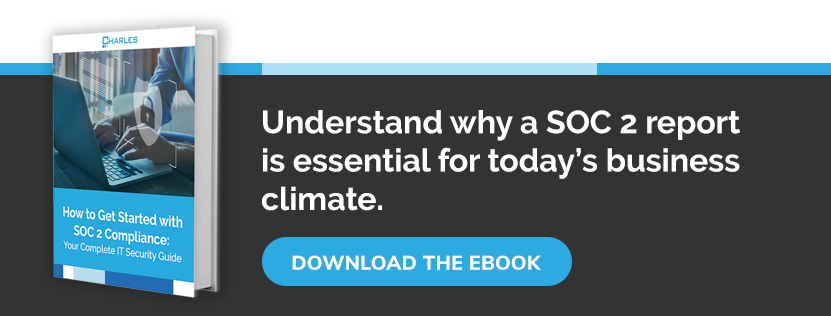.png)
No organization wants to do business with a high-risk vendor. In today’s increasingly complex cyber threat landscape, companies routinely demand trust and transparency so that they can be confident handing over their sensitive data. This may involve asking for a SOC 2 audit report, which will be required to secure and maintain high-value contracts.
Meeting the demands of any compliance regulation begins with an evaluation of the current state of your cybersecurity maturity. Only after conducting a thorough IT security assessment can you identify what’s working and what isn’t. It can also help you prepare for achieving SOC 2 compliance.
What are the SOC 1 and SOC 2 Compliance
SOC 1 was developed by the American Institute of Public Accountants to report on internal control over financial reporting. SOC 2 builds upon that original goal by covering five partially overlapping trust services criteria: security, availability, processing integrity, confidentiality, and privacy.
As such, SOC 1 and SOC 2 reports differ when it comes to scope. While SOC 1 is largely concerned with financial institutions and departments, SOC 2 has become a practical necessity for almost all service-based organizations. Understanding the differences between SOC 1 and SOC 2 reports will help you determine the best place to start and which measures you need to maintain moving forward.
|
Related article: Know the Difference: SOC 1 vs SOC 2 |
Where to Start with SOC 2 Compliance
An IT security assessment evaluates your internal controls, which govern the services you provide to your clients, and the measures in place to protect client data. This is a common method and starting point for validating and demonstrating your commitment to customer privacy and security.
Below are the ways an IT security assessment helps you become more prepared for compliance regulations such as SOC 2.
1. Identify Opportunities for Improvement
If you're able to evaluate your internal controls, then you'll be better able to define the risks facing your business and identify any opportunities for improvement. For example, a gap analysis will evaluate your entire network, including both internal and external computing resources, to identify any ‘gaps’ in security. An assessment typically includes many components that cover not only technical measures but also operational policies and employee security awareness.
If you're wondering when a good time is to complete an IT security assessment, it's right now. Too many companies don’t think about this until after they’ve suffered a data breach and the damage is already done. By taking a proactive approach, you'll be better able to prevent a breach from happening in the first place.
2. Document Your Cybersecurity Efforts
While protecting your and your client's data is obviously the main priority, it’s still important to demonstrate your efforts to achieve a high standard of information security. After all, many prospective and existing clients will ask if you’ve received a SOC 2 audit and may even require it. In fact, marketing teams can obtain a SOC 3 audit for general use (meaning no confidential information is included) that they can provide as an assurance of their firm's SOC 2 compliance efforts.
Many regulations also require companies to maintain proof of compliance in the form of up-to-date reports and audits, and SOC 2 is no exception. Having a robust security policy and recent IT security assessment provides precisely that kind of evidence.
3. Educate Your Employees on Security
Many people still think of cybersecurity as a technical challenge that remains solely in the domain of their company's IT department. Unfortunately, that’s the kind of mindset that leaves employees susceptible to social engineering scams. Almost all successful data breaches include a human element, which is why you also need to think about how people and processes fit into your information security strategy.
By uncovering potential risks and other issues, an IT security assessment can also serve as an educational experience. Given the key role SOC 2 compliance plays in vendor management and internal governance, educating your employees on its key principles will better prepare them for the risks they will likely face.
4. Reduce Operational Risk
Service-based companies face constant threats, including cyberattacks and data loss. Unforeseen outages can lead to increased customer churn and even reputational damage.
We're big on endless improvement, in fact, it's one of our core values, but to focus on that means that we need to know both sides of the equation: where we are and where we want to be. An IT assessment gives you the opportunity to compare your current situation with where you want to be. It serves as a starting point on a journey of endless improvement, whereby you proactively and iteratively reduce risk and avoid missed opportunities. SOC 2 compliance offers a way to document and demonstrate your efforts while you rest easy, knowing that you’ve achieved a high standard of information security that your customers can trust.
Are you ready for your IT Security Assessment?
Charles IT will put your current security system to the test to help you determine how close you are to achieving SOC 2 compliance. Contact us today to schedule a consultation!
Editor's Note: This post was originally published in January 2021 and has been updated for accuracy and comprehensiveness.




